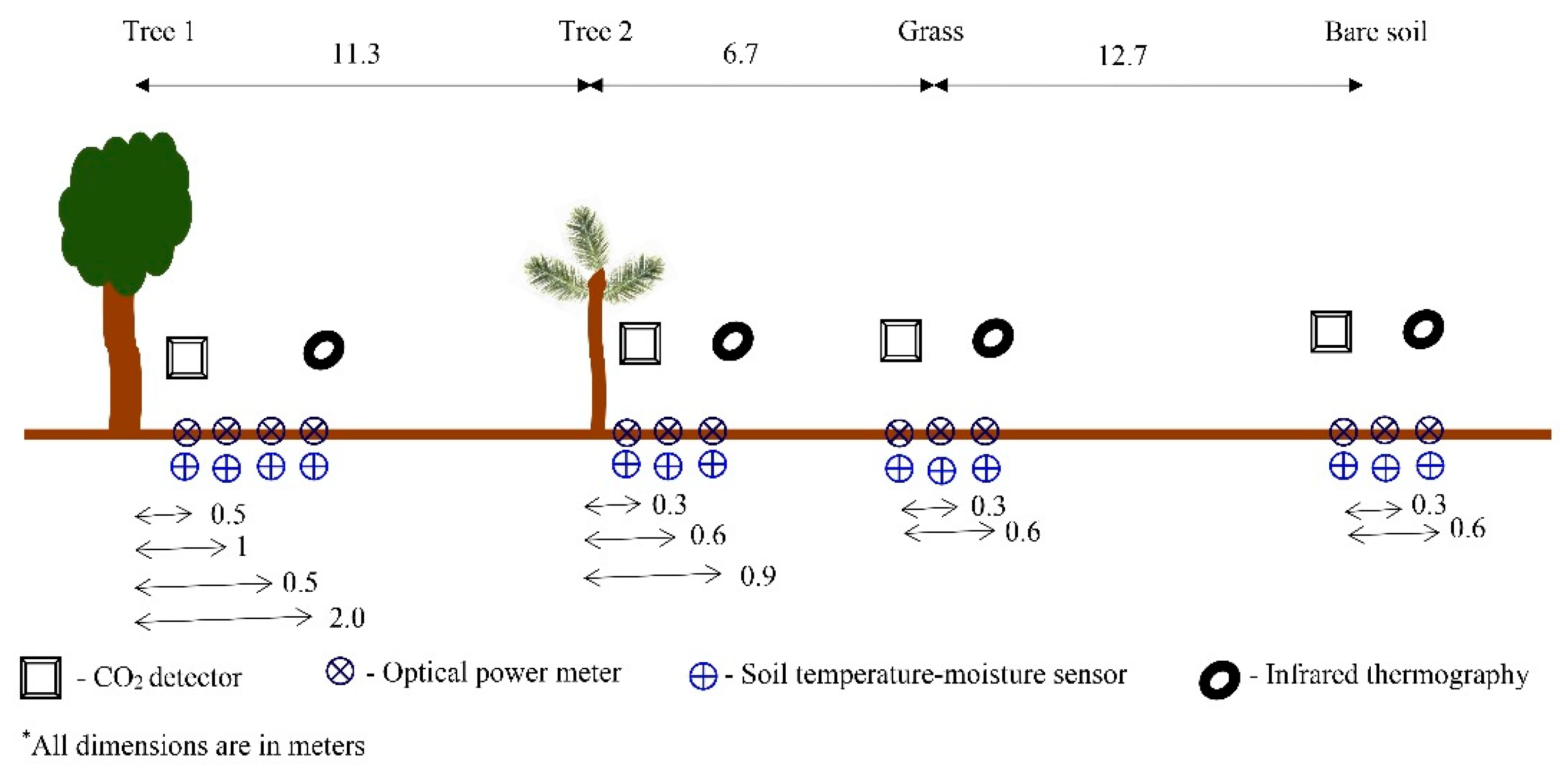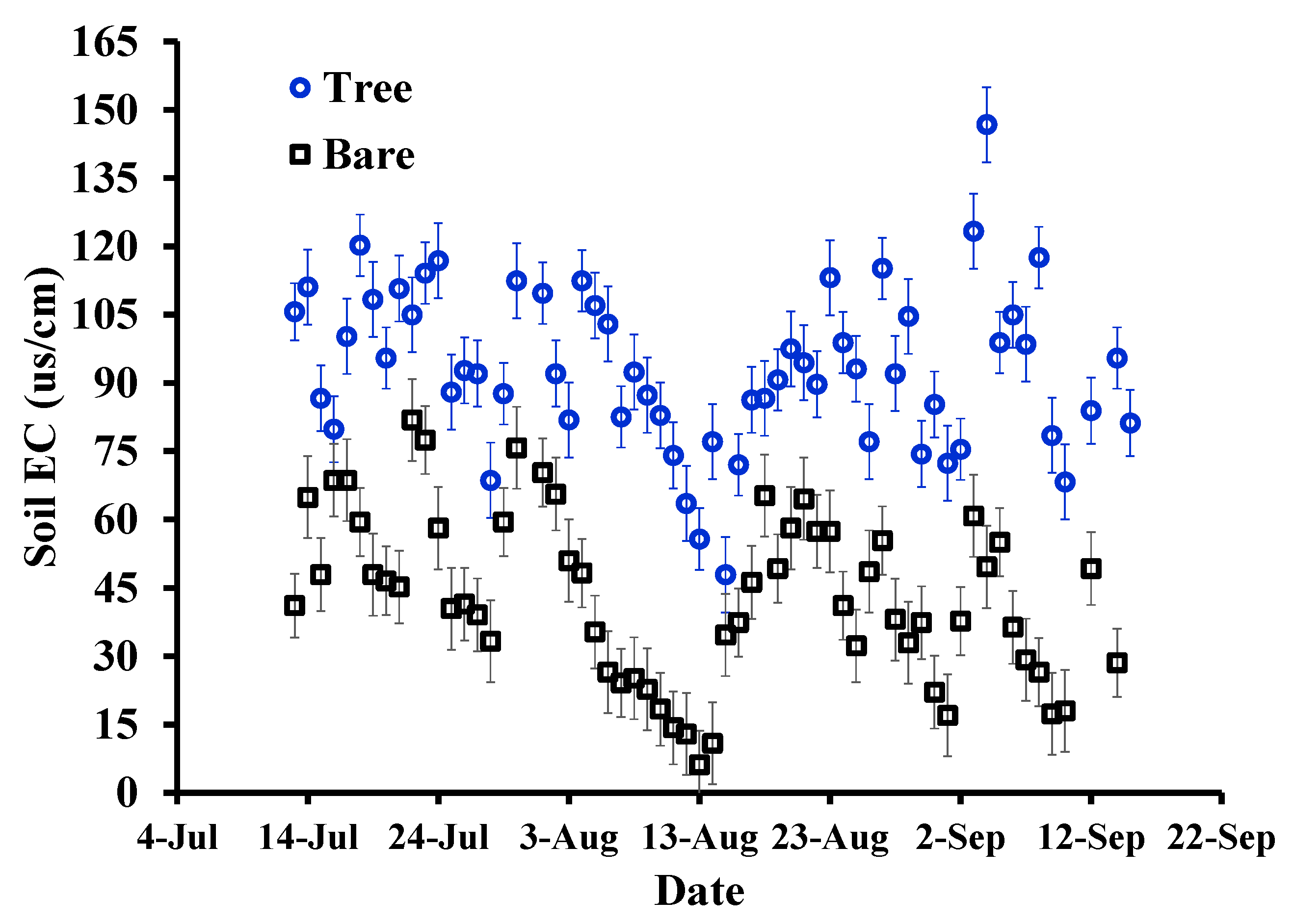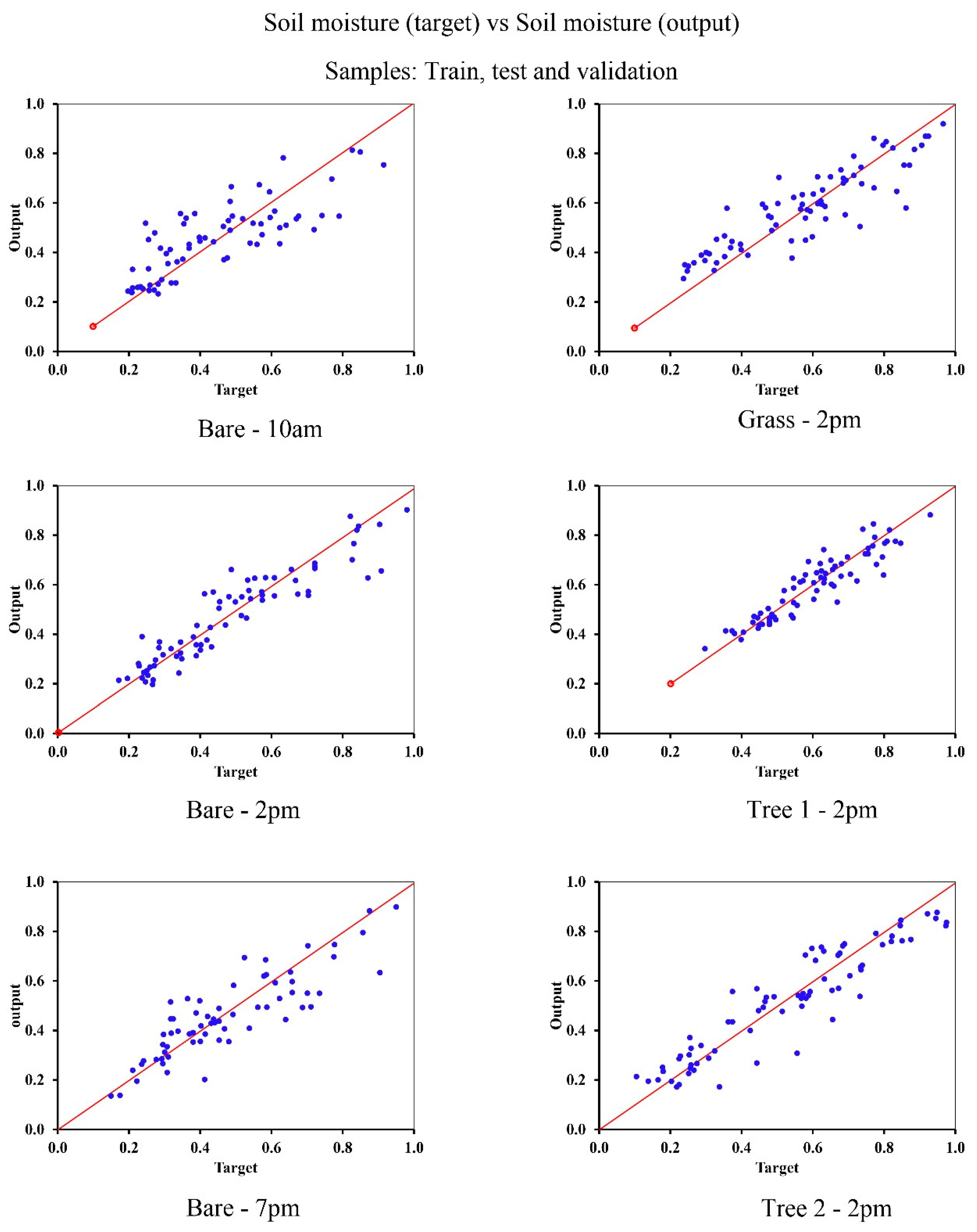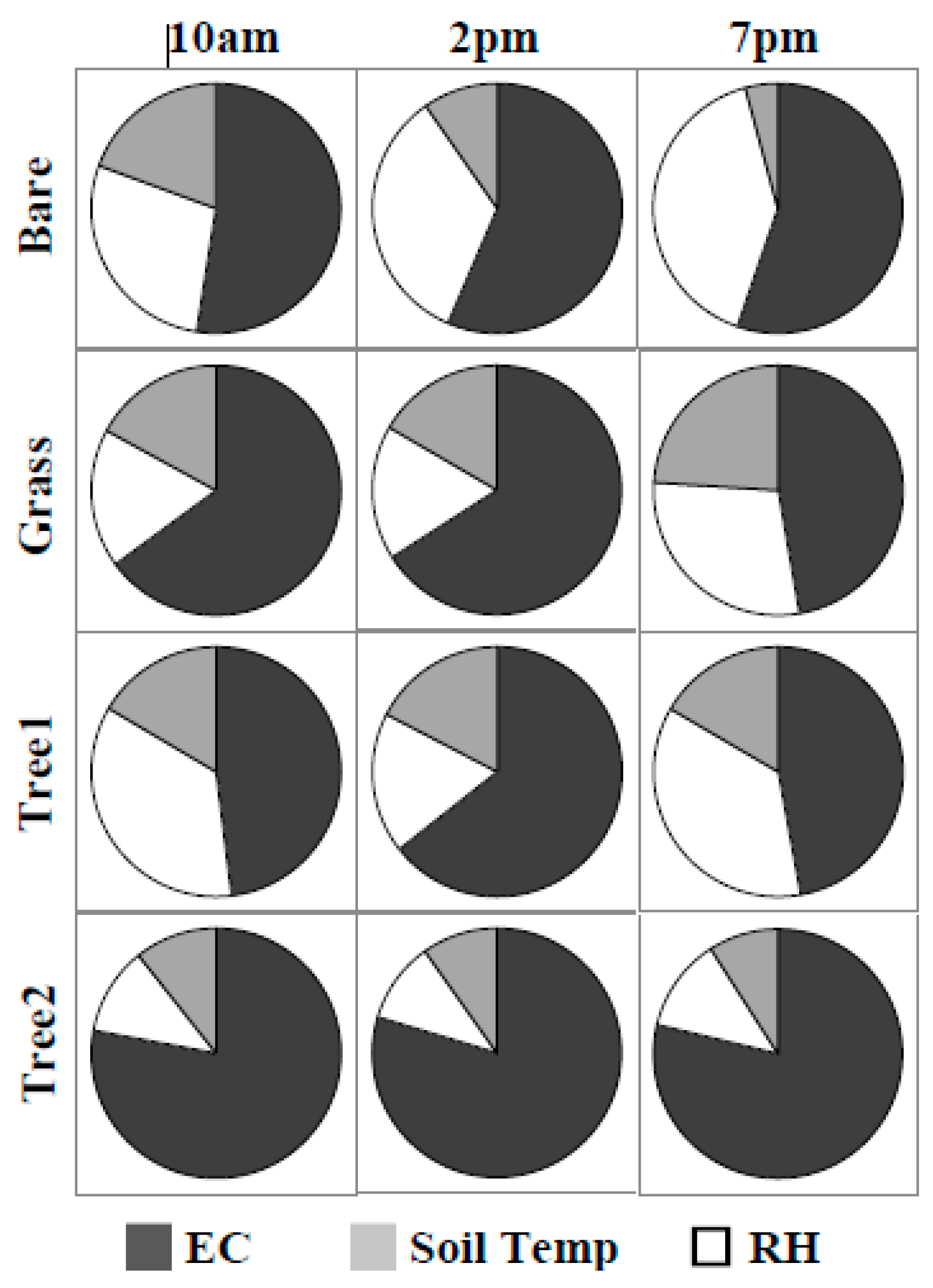A Novel Approach to Interpret Soil Moisture Content for Economical Monitoring of Urban Landscape
Abstract
1. Introduction
2. Materials and Methods
2.1. Field Monitoring Programme
2.1.1. Site Details
2.1.2. Soil Properties and Details of Vegetation
2.1.3. Experimental Setup and Instrumentation
2.2. Development of Model
3. Results and Discussion
3.1. Mean Soil Water Content
3.2. Temperature of the Soil
3.3. Mean Soil EC
4. Development of Model to Compute Soil EC
4.1. Performance of the Developed Models for Various Soil Covers
4.2. Sensitive Analysis to Explore the Relative Importance of Various Parameters on Water Content
4.3. Optimization Analysis of the Novel Model: Role of Various Parameters in Increasing and Decreasing Water Content
5. Conclusions
Author Contributions
Funding
Conflicts of Interest
References
- Maes, J.; Barbosa, A.; Baranzelli, C.; Zulian, G.; e Silva, F.B.; Vandecasteele, I.; Hiederer, R.; Liquete, C.; Paracchini, M.L.; Mubareka, S.; et al. More green infrastructure is required to maintain ecosystem services under current trends in land-use change in Europe. Landsc. Ecol. 2015, 30, 517–534. [Google Scholar] [CrossRef] [PubMed]
- Roe, M.; Mell, I. Negotiating value and priorities: Evaluating the demands of green infrastructure development. J. Environ. Plan. Manag. 2013, 56, 650–673. [Google Scholar] [CrossRef]
- Hansen, R.; Pauleit, S. From multifunctionality to multiple ecosystem services? A conceptual framework for multifunctionality in green infrastructure planning for urban areas. Ambio 2014, 43, 516–529. [Google Scholar] [CrossRef] [PubMed]
- Berretta, C.; Gnecco, I.; Lanza, L.G.; La Barbera, P. Hydrologic influence on stormwater pollution at two urban monitoring sites. Urban Water J. 2007, 4, 107–117. [Google Scholar] [CrossRef]
- Berretta, C.; Poë, S.; Stovin, V. Reprint of “Moisture content behaviour in extensive green roofs during dry periods: The influence of vegetation and substrate characteristics. J. Hydrol. 2014, 516, 37–49. [Google Scholar] [CrossRef]
- Segovia, C.; Gomez, J.D.; Gallardo, P.; Lozano, F.J.; Asensio, C. Soil nutrients losses by wind erosion in a citrus crop at southeast Spain. Eurasian Soil Sci. 2017, 50, 756–763. [Google Scholar] [CrossRef]
- Shamrikova, E.V.; Deneva, S.V.; Panyukov, A.N.; Kubik, O.S. Soils and Vegetation of the Khaipudyr Bay Coast of the Barents Sea. Eurasian Soil Sci. 2018, 51, 385–394. [Google Scholar] [CrossRef]
- Kostenko, I.V.; Opanasenko, N.E. Organic matter of technogenic soils and substrates on the dumps of sulfidic mine rock (carbonaceous shale) in Western Donets Basin. Eurasian Soil Sci. 2007, 40, 318–328. [Google Scholar] [CrossRef]
- Garg, A.; Bordoloi, S.; Ni, J.; Cai, W.; Maddibiona, P.G.; Mei, G.; Poulsen, T.G.; Lin, P. Influence of biochar addition on gas permeability in unsaturated soil. Geotech. Lett. 2019, 9, 66–71. [Google Scholar] [CrossRef]
- Liu, B.; Berretta, C.; Gnecco, I.; Ying, G.; Sansalone, J. Control of Highway Stormwater during Event and Interevent Retention in Best Management Practices. Transp. Res. Rec. J. Transp. Res. Board 2009, 2120, 115–122. [Google Scholar] [CrossRef]
- Gnecco, I.; Berretta, C.; Lanza, L.; La Barbera, P. Quality of stormwater runoff from paved surfaces of two production sites. Water Sci. Technol. 2006, 54, 177–184. [Google Scholar] [CrossRef] [PubMed][Green Version]
- Poë, S.; Stovin, V.; Berretta, C. Parameters influencing the regeneration of a green roof’s retention capacity via evapotranspiration. J. Hydrol. 2015, 523, 356–367. [Google Scholar] [CrossRef]
- Stovin, V.; Poë, S.; Berretta, C. A modelling study of long term green roof retention performance. J. Environ. Manag. 2013, 131, 206–215. [Google Scholar] [CrossRef] [PubMed]
- Stovin, V.; Poë, S.; De-Ville, S.; Berretta, C. The influence of substrate and vegetation configuration on green roof hydrological performance. Ecol. Eng. 2015, 85, 159–172. [Google Scholar] [CrossRef]
- Stovin, V. The potential of green roofs to manage urban stormwater. Water Environ. J. 2010, 24, 192–199. [Google Scholar] [CrossRef]
- Gadi, V.K.; Bordoloi, S.; Garg, A.; Sahoo, L.; Berretta, C.; Sekharan, S. Effect of shoot parameters on cracking in vegetated soil. Environ. Geotech. 2017, 5, 1–31. [Google Scholar] [CrossRef]
- Leung, A.K.; Garg, A.; Coo, J.L.; Ng, C.W.W.; Hau, B.C.H. Effects of the roots of Cynodon dactylon and Schefflera heptaphylla on water infiltration rate and soil hydraulic conductivity. Hydrol. Process. 2015, 29, 3342–3354. [Google Scholar] [CrossRef]
- Scanlan, C.A.; Hinz, C. Insights into the processes and effects of root-induced changes to soil hydraulic properties. In Proceedings of the 19th World Congress of Soil Science, Soil Solutions for a Changing World, Brisbane, Australia, 1–6 August 2010. [Google Scholar]
- Ng, C.W.W.; Ni, J.J.; Leung, A.K.; Zhou, C.; Wang, Z.J. Effects of planting density on tree growth and induced soil suction. Géotechnique 2016, 66, 711–724. [Google Scholar] [CrossRef]
- Bordoloi, S.; Gadi, V.K.; Hussain, R.; Sahoo, L.; Garg, A.; Sreedeep, S.; Mei, G.; Poulsen, T.G. Influence of fiber from waste weed Eichhornia Crassipes on water retention and cracking characteristics of vegetated soils. Geotech. Lett. 2018, 1–25. [Google Scholar] [CrossRef]
- Ni, J.; Leung, A.K.; Ng, C.W.W. Unsaturated hydraulic properties of vegetated soil under single and mixed planting conditions. Géotechnique 2018, 1–6. [Google Scholar] [CrossRef]
- Buczko, U.; Bens, O.; Hüttl, R. Changes in soil water repellency in a pine–beech forest transformation chronosequence: Influence of antecedent rainfall and air temperatures. Ecol. Eng. 2007, 31, 154–164. [Google Scholar] [CrossRef]
- Gadi, V.K.; Tang, Y.-R.; Das, A.; Monga, C.; Garg, A.; Berretta, C.; Sahoo, L. Spatial and temporal variation of hydraulic conductivity and vegetation growth in green infrastructures using infiltrometer and visual technique. Catena 2017, 155, 20–29. [Google Scholar] [CrossRef]
- Raffelli, G.; Previati, M.; Canone, D.; Gisolo, D.; Bevilacqua, I.; Capello, G.; Biddoccu, M.; Cavallo, E.; Deiana, R.; Cassiani, G.; et al. Local- and Plot-Scale Measurements of Soil Moisture: Time and Spatially Resolved Field Techniques in Plain, Hill and Mountain Sites. Water 2017, 9, 706. [Google Scholar] [CrossRef]
- Garg, A.; Vijayaraghavan, V.; Zhang, J.; Lam, J.S.L. Robust model design for evaluation of power characteristics of the cleaner energy system. Renew. Energy 2017, 112, 302–313. [Google Scholar] [CrossRef]
- Roth, C.H.; Malicki, M.A.; Plagge, R. Empirical evaluation of the relationship between soil dielectric constant and volumetric water content as the basis for calibrating soil moisture measurements by TDR. J. Soil Sci. 1992, 43, 1–13. [Google Scholar] [CrossRef]
- Ain-Lhout, F.; Boutaleb, S.; Diaz-Barradas, M.C.; Jauregui, J.; Zunzunegui, M.; Barradas, M.C.D. Monitoring the evolution of soil moisture in root zone system of Argania spinosa using electrical resistivity imaging. Agric. Water Manag. 2016, 164, 158–166. [Google Scholar] [CrossRef]
- Kizito, F.; Campbell, C.; Campbell, G.; Cobos, D.; Teare, B.; Carter, B.; Hopmans, J. Frequency, electrical conductivity and temperature analysis of a low-cost capacitance soil moisture sensor. J. Hydrol. 2008, 352, 367–378. [Google Scholar] [CrossRef]
- Dick, J.; Tetzlaff, D.; Bradford, J.; Soulsby, C. Using repeat electrical resistivity surveys to assess heterogeneity in soil moisture dynamics under contrasting vegetation types. J. Hydrol. 2018, 559, 684–697. [Google Scholar] [CrossRef]
- Malicki, M.; Plagge, R.; Roth, C. Improving the calibration of dielectric TDR soil moisture determination taking into account the solid soil. Eur. J. Soil Sci. 1996, 47, 357–366. [Google Scholar] [CrossRef]
- Matsushima, D.; Asanuma, J.; Kaihotsu, I. Thermal Inertia Approach Using a Heat Budget Model to Estimate the Spatial Distribution of Surface Soil Moisture over a Semiarid Grassland in Central Mongolia. J. Hydrometeorol. 2018, 19, 245–265. [Google Scholar] [CrossRef]
- Jensen, A.; McKee, M.; Torres-Rua, A.; Hassan-Esfahani, L.; Torres-Rua, A.; Hassan-Esfahani, L.; Torres-Rua, A. Spatial Root Zone Soil Water Content Estimation in Agricultural Lands Using Bayesian-Based Artificial Neural Networks and High- Resolution Visual, NIR, and Thermal Imagery. Irrig. Drain. 2017, 66, 273–288. [Google Scholar]
- Idso, S.B.; Schmugge, T.J.; Jackson, R.D.; Reginato, R.J. The utility of surface temperature measurements for the remote sensing of surface soil water status. J. Geophys. Res. Space Phys. 1975, 80, 3044–3049. [Google Scholar] [CrossRef]
- Carlson, T.N.; Gillies, R.R.; Perry, E.M. A method to make use of thermal infrared temperature and NDVI measurements to infer surface soil water content and fractional vegetation cover. Remote Sens. Rev. 1994, 9, 161–173. [Google Scholar] [CrossRef]
- Leelamanie, D.A.L. Changes in soil water content with ambient relative humidity in relation to the organic matter and clay. Trop. Agric. Res. Ext. 2010, 13, 6–10. [Google Scholar] [CrossRef]
- Bai, W.; Kong, L.; Guo, A. Effects of physical properties on electrical conductivity of compacted lateritic soil. J. Rock Mech. Geotech. Eng. 2013, 5, 406–411. [Google Scholar] [CrossRef]
- Liu, J.; Duan, N.; Cui, L.; Zhu, N. DEM investigation of installation responses of jacked open-ended piles. Acta Geotech. 2019, 1–15. [Google Scholar] [CrossRef]
- Gadi, V.K.; Hussain, R.; Bordoloi, S.; Hossain, S.; Singh, S.R.; Garg, A.; Sekharan, S.; Karangat, R.; Lingaraj, S. Relating stomatal conductance and surface area with evapotranspiration induced suction in a heterogeneous grass cover. J. Hydrol. 2018. [Google Scholar] [CrossRef]
- Garg, A.; Coo, J.L.; Ng, C.W.W. Field study on influence of root characteristics on soil suction distribution in slopes vegetated with Cynodon dactylon and Schefflera heptaphylla. Earth Surf. Process. Landf. 2015, 40, 1631–1643. [Google Scholar] [CrossRef]
- Gadi, V.K.; Bordoloi, S.; Garg, A.; Kobayashi, Y.; Sahoo, L. Improving and correcting unsaturated soil hydraulic properties with plant parameters for agriculture and bioengineered slopes. Rhizosphere 2016, 1, 58–78. [Google Scholar] [CrossRef]
- Gregory, J.H.; Dukes, M.D.; Jones, P.H.; Miller, G.L. Effect of urban soil compaction on infiltration rate. J. Soil Water Conserv. 2006, 61, 117–124. [Google Scholar] [CrossRef]
- Quails, R.J.; Scott, J.M.; Deoreo, W.B. Soil Moisture Sensors for Urban Landscape Irrigation: Effectweness and Reliability. JAWRA J. Am. Water Resour. Assoc. 2001, 37, 547–559. [Google Scholar] [CrossRef]
- Howard, K.W.; Beck, P.J. Hydrogeochemical implications of groundwater contamination by road de-icing chemicals. J. Contam. Hydrol. 1993, 12, 245–268. [Google Scholar] [CrossRef]
- Perera, N.; Gharabaghi, B.; Howard, K. Groundwater chloride response in the Highland Creek watershed due to road salt application: A re-assessment after 20years. J. Hydrol. 2013, 479, 159–168. [Google Scholar] [CrossRef]
- Ramakrishna, D.M.; Viraraghavan, T. Environmental Impact of Chemical Deicers—A Review. Water Air Soil Pollut. 2005, 166, 49–63. [Google Scholar] [CrossRef]
- Boyer, J.S. Plant Productivity and Environment. Science 1982, 218, 443–448. [Google Scholar] [CrossRef]
- Hoffman, G.J.; Rawlins, S.L.; Garber, M.J.; Cullen, E.M. Water Relations and Growth of Cotton as Influenced by Salinity and Relative Humidity1. Agron. J. 1971, 63, 822. [Google Scholar] [CrossRef]
- Williams, B.; Hoey, D. The use of electromagnetic induction to detect the spatial variability of the salt and clay contents of soils. Soil Res. 1987, 25, 21. [Google Scholar] [CrossRef]
- Jougnot, D.; Jiménez-Martínez, J.; Legendre, R.; Le Borgne, T.; Méheust, Y.; Linde, N. Impact of small-scale saline tracer heterogeneity on electrical resistivity monitoring in fully and partially saturated porous media: Insights from geoelectrical milli-fluidic experiments. Adv. Water Resour. 2018, 113, 295–309. [Google Scholar] [CrossRef]
- Sudduth, K.; Drummond, S.; Kitchen, N. Accuracy issues in electromagnetic induction sensing of soil electrical conductivity for precision agriculture. Comput. Electron. Agric. 2001, 31, 239–264. [Google Scholar] [CrossRef]
- Monteith, J.L. Evaporation and environment. Symp. Soc. Exp. Biol. 1965, 19, 205–234. [Google Scholar]
- Qiu, R.; Liu, C.; Wang, Z.; Yang, Z.; Jing, Y. Effects of irrigation water salinity on evapotranspiration modified by leaching fractions in hot pepper plants. Sci. Rep. UK 2017, 7, 7231. [Google Scholar] [CrossRef] [PubMed][Green Version]
- Li, S.; Kang, S.; Li, F.; Zhang, L. Evapotranspiration and crop coefficient of spring maize with plastic mulch using eddy covariance in northwest China. Agric. Water Manag. 2008, 95, 1214–1222. [Google Scholar] [CrossRef]
- Garg, A.; Gadi, V.K.; Feng, Y.C.; Lin, P.; Qinhua, W.; Ganesan, S.; Mei, G. Dynamics of soil water content using field monitoring and AI: A case study of a vegetated soil in an urban environment in China. Sustain. Comput. Inform. Syst. 2019. [Google Scholar] [CrossRef]
- Gadi, V.K.; Garg, A.; Prakash, S.; Wei, L.; Andriyas, S. A non-intrusive image analysis technique for measurement of heterogeneity in grass species around tree vicinity in a green infrastructure. Measurement 2018, 114, 132–143. [Google Scholar] [CrossRef]
- Hoffman, G.J.; Evans, R.G.; Jensen, M.E.; Martin, D.L.; Elliott, R.L. Design and Operation of Farm Irrigation Systems; American Society of Agricultural and Biological Engineers: St. Joseph, MI, USA, 2007. [Google Scholar]
- Gadi, V.; Singh, S.; Singhariya, M.; Garg, A. Modeling soil-plant-water interaction: effects of canopy and root parameters on soil suction and stability of green infrastructure. Eng. Comput. 2018, 35, 1543–1566. [Google Scholar] [CrossRef]
- Cai, J.; Liu, Y.; Lei, T.; Pereira, L.S. Estimating reference evapotranspiration with the FAO Penman–Monteith equation using daily weather forecast messages. Agric. For. Meteorol. 2007, 145, 22–35. [Google Scholar] [CrossRef]
- Allen, R.G.; Pereira, L.S.; Raes, D.; Smith, M. Crop Evapotranspiration-Guidelines for Computing Crop Water Requirements-FAO Irrigation and Drainage Paper; FAO: Rome, Italy, 1998. [Google Scholar]
- A.S.T.M. D1452-16. Standard Practice for Soil Exploration and Sampling by Auger Borings; ASTM International: West Conshohocken, PA, USA, 2016. [Google Scholar]
- A.S.T.M. D4220-14. Standard Practices for Preserving and Transporting Soil Samples; ASTM International: West Conshohocken, PA, USA, 2014. [Google Scholar]
- A.S.T.M. D2487-10. Standard Practice for Classification of Soils for Engineering Purposes (Unified Soil Classification System); ASTM International: West Conshohocken, PA, USA, 2010. [Google Scholar]
- A.S.T.M. D4318-93. Standard Test Methods for Liquid Limit, Plastic Limit and Plasticity Index of Soils; ASTM International: West Conshohocken, PA, USA, 1993. [Google Scholar]
- A.S.T.M. D854-10. Standard Test Methods for Specific Gravity of Soil Solids by Water Pycnometer; ASTM International: West Conshohocken, PA, USA, 2010. [Google Scholar]
- A.S.T.M. D5084-03. Standard Test Methods for Measurement of Hydraulic Conductivity of Saturated Porous Materials Using a Flexible Wall Permeameter; ASTM International: West Conshohocken, PA, USA, 2003. [Google Scholar]
- Devices, D. ECH2O Soil Moisture sEnsor: Operator’s Manual for Models EC-20, EC-10 and EC-5, Version 5; Decagon Devices Inc.: Pullman, WA, USA, 2006; pp. 6–10. [Google Scholar]
- Devices, D. 5TE, Water Content, EC and Temperature Sensors: Operator’s Manual, Version 6; Decagon Devices Inc.: Pullman, WA, USA, 2010; pp. 6–8. [Google Scholar]
- Garg, A.; Li, J.; Hou, J.; Berretta, C.; Garg, A. A new computational approach for estimation of wilting point for green infrastructure. Measurement 2017, 111, 351–358. [Google Scholar] [CrossRef]
- Simon, A.; Collison, A.J.C. Quantifying the mechanical and hydrologic effects of riparian vegetation on streambank stability. Earth Surf. Process. Landf. 2002, 27, 527–546. [Google Scholar] [CrossRef]
- Smethurst, J.A.; Clarke, D.; Powrie, W. Seasonal changes in pore water pressure in a grass-covered cut slope in London Clay. Géotechnique 2006, 56, 523–537. [Google Scholar] [CrossRef]
- Ng, C.; Ni, J.; Leung, A.; So, P. Investigation of plant growth and transpiration-induced matric suction under mixed grass–tree conditions. Can. Geotech. J. 2017, 54, 561–573. [Google Scholar]
- Kimball, B.A.; Lemon, E.R. Air Turbulence Effects upon Soil Gas Exchange1. Soil Sci. Soc. Am. J. 1971, 35, 16. [Google Scholar] [CrossRef]
- Baldocchi, D.D.; Meyers, T.P. Trace gas exchange above the floor of a deciduous forest: 1. Evaporation and CO2 efflux. J. Geophys. Res. Atmos. 1991, 96, 7271–7285. [Google Scholar] [CrossRef]
- Webb, E.; Pearman, G.; Leuning, R. Correction of flux measurements for density effects due to heat and water vapour transfer. Q. J. R. Meteorol. Soc. 1980, 106, 85–100. [Google Scholar] [CrossRef]
- Mann, M.E.; Schmidt, G.A. Ground vs. surface air temperature trends: Implications for borehole surface temperature reconstructions. Geophys. Res. Lett. 2003, 30, 10–1029. [Google Scholar] [CrossRef]
- Paul, K.I.; Polglase, P.J.; Smethurst, P.J.; O’Connell, A.M.; Carlyle, C.J.; Khanna, P.K. Soil temperature under forests: A simple model for predicting soil temperature under a range of forest types. Agric. For. Meteorol. 2004, 121, 167–182. [Google Scholar] [CrossRef]
- Balisky, A.C.; Burton, P.J. Distinction of soil thermal regimes under various experimental vegetation covers. Can. J. Soil Sci. 1993, 73, 411–420. [Google Scholar] [CrossRef]
- McCarter, W.J. The electrical resistivity characteristics of compacted clays. Géotechnique 1984, 34, 263–267. [Google Scholar] [CrossRef]
- Abu-Hassanein, Z.S.; Benson, C.H.; Blotz, L.R. Electrical Resistivity of Compacted Clays. J. Geotech. Eng. 1996, 122, 397–406. [Google Scholar] [CrossRef]
- Brevik, E.C.; Fenton, T.E.; Lazari, A. Soil electrical conductivity as a function of soil water content and implications for soil mapping. Precis. Agric. 2006, 7, 393–404. [Google Scholar] [CrossRef]
- Garg, A.; Hazra, B.; Zhu, H.; Wen, Y. A simplified probabilistic analysis of water content and wilting in soil vegetated with non-crop species. Catena 2019, 175, 123–131. [Google Scholar] [CrossRef]
- Garg, A.; Leung, A.; Ng, C. Transpiration reduction and root distribution functions for a non-crop species Schefflera heptaphylla. Catena 2015, 135, 78–82. [Google Scholar] [CrossRef]
- Cao, Y.; Repo, T.; Silvennoinen, R.; Lehto, T.; Pelkonen, P. An appraisal of the electrical resistance method for assessing root surface area. J. Exp. Bot. 2010, 61, 2491–2497. [Google Scholar] [CrossRef] [PubMed]
- Aubrecht, L.; Stanek, Z.; Koller, J. Electrical measurement of the absorption surfaces of tree roots by the earth impedance method: 1. Theory. Tree Physiol. 2006, 26, 1105–1112. [Google Scholar] [CrossRef] [PubMed]
- Anderson-Cook, C.M.; Alley, M.M.; Roygard, J.K.F.; Khosla, R.; Noble, R.B.; Doolittle, J.A. Differentiating Soil Types Using Electromagnetic Conductivity and Crop Yield Maps. Soil Sci. Soc. Am. J. 2002, 66, 1562. [Google Scholar] [CrossRef]
- Kudeyarov, V.N.; Demkin, V.A.; Gilichinskii, D.A.; Goryachkin, S.V.; Rozhkov, V.A.; Kudeyarov, V.; Goryachkin, S. Global climate changes and the soil cover. Eurasian Soil Sci. 2009, 42, 953–966. [Google Scholar] [CrossRef]








| Parameters | Values Assigned |
|---|---|
| Training data | 0.70 |
| Testing data | 0.15 |
| Validation data | 0.15 |
| Number of hidden layer | 1 |
| Number of neurons in hidden layer | 3 to 10 |
| Target goal mean square error | 10−5 |
| Minimum performance gradient | 10−5 |
| Seed for sampling | 103 |
| Sensitivity Analysis | |||
|---|---|---|---|
| Samples: Train, Test, Validation | |||
| Networks | EC | RH | Soil |
| Temp | |||
| Without vegetation-10 | 2.79 | 1.48 | 1.12 |
| Without vegetation-14 | 9.08 | 5.53 | 1.62 |
| Without vegetation-19 | 17.81 | 13.10 | 1.36 |
| Grassed soil-10 | 5.69 | 1.61 | 1.48 |
| Grassed soil-14 | 4.07 | 1.12 | 1.13 |
| Grassed soil-19 | 3.90 | 2.37 | 1.88 |
| Treed soil 1-10 | 3.38 | 2.57 | 1.21 |
| Treed soil 1-14 | 8.71 | 2.51 | 2.42 |
| Treed soil 1-19 | 5.97 | 4.72 | 2.08 |
| Treed soil 2-10 | 7.16 | 1.12 | 0.97 |
| Treed soil 2-14 | 8.62 | 1.17 | 1.11 |
| Treed soil 2-19 | 9.72 | 1.46 | 1.07 |
| Sensitivity Analysis | |||
|---|---|---|---|
| Samples: Train, Test, Validation | |||
| Networks | EC (%) | RH (%) | Soil |
| Temp (%) | |||
| Without vegetation-10 | 52.53 | 28.13 | 19.51 |
| Without vegetation-14 | 56.54 | 33.76 | 9.68 |
| Without vegetation-19 | 55.32 | 40.48 | 4.16 |
| Grassed soil-10 | 64.87 | 17.97 | 17.12 |
| Grassed soil-14 | 65.86 | 17.52 | 16.57 |
| Grassed soil-19 | 47.34 | 28.77 | 24.13 |
| Treed soil 1-10 | 47.97 | 35.52 | 16.46 |
| Treed soil 1-14 | 64.43 | 18.31 | 17.44 |
| Treed soil 1-19 | 47.08 | 36.31 | 16.64 |
| Treed soil 2-10 | 77.89 | 11.38 | 10.72 |
| Treed soil 2-14 | 79.72 | 10.60 | 9.79 |
| Treed soil 2-19 | 78.83 | 12.24 | 9.12 |
| Loaded XML Files | Results, Simplex Search Dependent Name: Soil Moisture Target = Highest = 1.0 | |||
|---|---|---|---|---|
| Soil temp-X1 | EC-X2 | RH-X3 | Soil moisture-Y | |
| Without vegetation-10 | 0.89 | 0.73 | 0.80 | 1.00 |
| Without vegetation-14 | 0.76 | 0.90 | 0.39 | 1.00 |
| Without vegetation-19 | 1.09 | 1.29 | 0.89 | 0.96 |
| Grassed soil-10 | 0.84 | 1.16 | 1.00 | 0.93 |
| Grassed soil-14 | 0.66 | 1.00 | 1.00 | 0.89 |
| Grassed soil-19 | 0.77 | 0.26 | 1.00 | 1.00 |
| Treed soil 1-10 | 0.88 | 0.97 | 0.76 | 1.00 |
| Treed soil 1-14 | 0.79 | 0.30 | 1.00 | 0.97 |
| Treed soil 1-19 | 0.83 | 0.97 | 0.85 | 1.00 |
| Treed soil 2-10 | 0.73 | 0.98 | 0.73 | 1.00 |
| Treed soil 2-14 | 0.70 | 1.00 | 0.98 | 0.89 |
| Treed soil 2-19 | 0.80 | 1.00 | 1.00 | 0.90 |
| Loaded XML Files | Results, Simplex Search Dependent Name: Soil Moisture Target = Lowest = 0.2 | |||
|---|---|---|---|---|
| Soil temp-X1 | EC-X2 | RH-X3 | Soil moisture-Y | |
| Without vegetation-10 | 0.86 | 0.07 | 0.35 | 0.19 |
| Without vegetation-14 | 0.87 | 0.08 | 0.64 | 0.19 |
| Without vegetation-19 | 0.95 | 0.02 | 0.93 | 0.19 |
| Grassed soil-10 | 0.83 | −0.29 | 0.96 | 0.25 |
| Grassed soil-14 | 1.00 | 0.09 | 0.41 | 0.29 |
| Grassed soil-19 | 1.00 | 0.14 | 0.70 | 0.22 |
| Treed soil 1-10 | 1.00 | 0.29 | 0.55 | 0.46 |
| Treed soil 1-14 | 1.00 | 0.89 | 0.39 | 0.33 |
| Treed soil 1-19 | 0.89 | 0.29 | 0.60 | 0.31 |
| Treed soil 2-10 | 1.00 | 0.09 | 0.80 | 0.30 |
| Treed soil 2-14 | 0.85 | 0.11 | 0.80 | 0.18 |
| Treed soil 2-19 | 0.93 | 0.06 | 0.86 | 0.18 |
© 2019 by the authors. Licensee MDPI, Basel, Switzerland. This article is an open access article distributed under the terms and conditions of the Creative Commons Attribution (CC BY) license (http://creativecommons.org/licenses/by/4.0/).
Share and Cite
Liu, J.; Gadi, V.K.; Garg, A.; Ganesan, S.P.; GuhaRay, A. A Novel Approach to Interpret Soil Moisture Content for Economical Monitoring of Urban Landscape. Sustainability 2019, 11, 5609. https://doi.org/10.3390/su11205609
Liu J, Gadi VK, Garg A, Ganesan SP, GuhaRay A. A Novel Approach to Interpret Soil Moisture Content for Economical Monitoring of Urban Landscape. Sustainability. 2019; 11(20):5609. https://doi.org/10.3390/su11205609
Chicago/Turabian StyleLiu, Junwei, Vinay Kumar Gadi, Ankit Garg, Suriya Prakash Ganesan, and Anasua GuhaRay. 2019. "A Novel Approach to Interpret Soil Moisture Content for Economical Monitoring of Urban Landscape" Sustainability 11, no. 20: 5609. https://doi.org/10.3390/su11205609
APA StyleLiu, J., Gadi, V. K., Garg, A., Ganesan, S. P., & GuhaRay, A. (2019). A Novel Approach to Interpret Soil Moisture Content for Economical Monitoring of Urban Landscape. Sustainability, 11(20), 5609. https://doi.org/10.3390/su11205609






